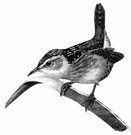ThesaurusAntonymsRelated WordsSynonymsLegend:
| Noun | 1. |  Cistothorus platensis - small American wren inhabiting wet sedgy meadows Cistothorus platensis - small American wren inhabiting wet sedgy meadowsmarsh wren - a wren of the genus Cistothorus that frequents marshes |
Based on WordNet 3.0, Farlex clipart collection. © 2003-2012 Princeton University, Farlex Inc.
All content on this website, including dictionary, thesaurus, literature, geography, and other reference data is for informational purposes only. This information should not be considered complete, up to date, and is not intended to be used in place of a visit, consultation, or advice of a legal, medical, or any other professional.
 Cistothorus platensis - small American wren inhabiting wet sedgy meadows
Cistothorus platensis - small American wren inhabiting wet sedgy meadows